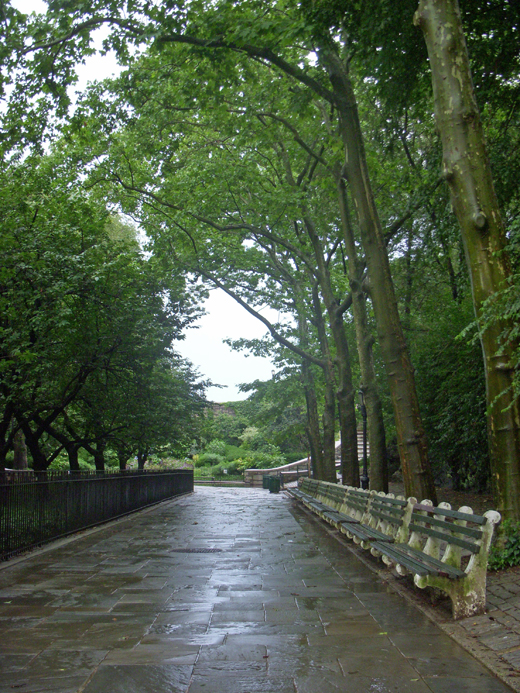Weekend Open Thread:
Park
last Week at Portico: It was beneath us, of course, but we went to see Todd Phillips’s The Hangover last week. We went alone, thinking it unwise to tell anyone that we were going, much less to ask anyone to join us. We told ourselves that the movie would be surprisingly different in unexpected ways, but at least we don’t have to take back saying that to anybody else. We also read Geoff Dyer’s Jeff in Venice, Death in Varanasi , and decided that it’s a first-rate piece of conceptual art. Fun to read, too. Rather more engaging, or at least more geared to our possibly vétuste sensibilities, was this week’s New Yorker story, Lorrie Moore’s “Childcare.”
As for this week’s Book Review, the one truly good review in the entire issue was written by Liesl Schillinger, who is a critic. I’m not saying that Ms Schillinger ought never to write a novel, as long as she learns who to write one better than any of the novelists appearing this week knows how to play critic. Caleb Crain, who clearly speaks for all of those young gents (as I’ve no doubt most of them are) who strongly dislike the work and whimsy of Alain de Botton, ought to have the courage of his animus, and express himself plainly instead of resorting to condescending snark. Ha! Now there’s no need for you to click throught to this week’s Book Review review.


A beautiful photo, RJ. I find your comment (indeed the argument which introduces it too), very insightful. What a shame none of it appears on the blog. so I’ll put a little here to share with others:
“Parks are perhaps the most important optional urban amenity, but it’s wrong, I think, too see them as outposts of aboriginal nature in the concrete fabric of the modern city. For one thing, people are not in fact drawn to aboriginal nature; instead, they populate it with, and abandon it to, mythical monsters. What parks are outposts of is the commons: a space open to everyone precisely because no one inhabits it. That’s why we think of parks as refuges, even when we enter them in order to meet friends, to sit on a bench for a long talk perhaps. Because no one possesses that bench, it serves as an escape from all things that do possess us outside the park ..”
I love the photos, but the plugins are too much for me as they take such time to download and I don’t come onto the Net to watch little bits of film.
I responded to another blague a while back and want to return to that to qualify what I said: I don’t have trouble making acquaintances when I go to impersonal places or clubs, especially regularly. What I do have trouble doing is making the transference from that place to say somewhere else and then to my or the person’s house; I have trouble jumping that gap and so don’t make friends easily. The rest of what I said I still agree with: I think this is common, and those who can make friends have a gift.
Ellen
Ellen
The park, as we know it, is truly an urban phenomenon. The minute land is enclosed to create or preserve a state of nature, iot paradoxically ceases to be “Nature” at all.
It’s funny how parks have developed. Historically, the closest thing to our American public parks has actually been their inspiration and direct predecessors, the royal parks of Europe. It is a fact that most royal domains were open to the public, as opposed to those parks of the nobility, which were essentially private domains. Royal parks, while having limitations of use, such as closure during royal festivities, or the circumscription against poaching, were truly more accessible, so much so that their becoming public parks in name after revolutions or enlightened gifting by later monarchs, often went unremarked, as opposed to the later opening of private noble domains and private squares in towns. this enforces the notion of the monarch and the populace having a direct connection, often in opposition to the noble caste; the King and the Commons is the State.
It is fortunate that New York set the aesthetic standard for most urban public parks in the United States, with its conscious attempt to avoid over- manicuring. While Central Park’s only truly native natural features are the granite outcroppings left by the last Ice Age (even most of the soil, and certainly all the plantings, were “imported”) the attempt was to create as “naturalistic” an ambiance as possible; with faux woodlands and artfully designed “waterfalls” and meadows. We have lost some of this over the decades, as lauditory statuary and formal bits of garden intruded on the original “Greensward” plan of Vaux and Olmstead. Political graft and municipal neglect also diminished the original intention, though truth to tell, the design was so strong, it was able to weather these onslaughts, well-intentioned or not, so that now, under the aegis of the quasi-private Central Park Conservancy, the park, and by imitation, all United States urban parks, have been brought back to their former glory, fulfilling their roles of civilizing the inhabitants of the city, of whatever social caste, making of them true citizens with a stake in the park’s, and by extension, the city’s future.